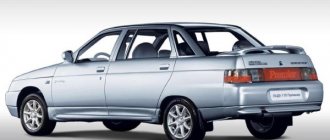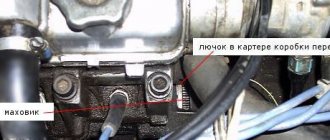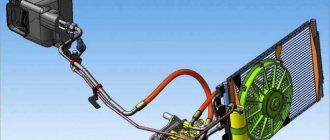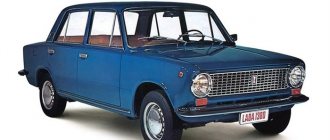We present to your attention an overview of the fuel consumption indicators of rear-wheel drive VAZ cars of the first family - sedans 2101, 21011, 21013, station wagons 2102, 21021, 21023 with carburetor engines. Consumption rates are calculated for 92nd gasoline. The mileage of the tested vehicles at the time of measurements did not exceed 30,000 km. All of them were in good technical condition.
It should be noted that for each specific vehicle, fuel consumption is individual and may not always coincide with the passport one. The parameters presented below can be used by car owners when determining the fuel consumption of their own car as a reference, when tuning the engine to minimum consumption, increasing its power and throttle response, etc.
Engine 2101, 1.2 l, 79.8 kW/58.7 hp, four-speed gearbox.
Highway: 90 km/h – 7.4 l /100 km, 120 km/h – 9.9 l /100 km
City – 11.0 l /100 km
VAZ 21011
Engine 21011, 1.3 l, 86.6 kW/63.7 hp, four-speed gearbox.
Highway: 90 km/h – 7.5 l /100 km, 120 km/h – 10.0 l /100 km
City – 11.1 l /100 km
VAZ 21013
Engine 2101, 1.2 l, 79.8 kW/58.7 hp, four-speed gearbox.
Highway: 90 km/h – 7.4 l /100 km, 120 km/h – 9.9 l /100 km
City – 11.0 l /100 km
VAZ 2102
Engine 2101, 1.2 l, 79.8 kW/58.7 hp, four-speed gearbox.
Highway: 90 km/h – 7.4 l /100 km, 120 km/h – 10.1 l /100 km
City – 10.8 l /100 km
VAZ 21021
Engine 21011, 1.3 l, 86.6 kW/63.7 hp, four-speed gearbox.
Highway: 90 km/h – 7.6 l /100 km, 120 km/h – 10.2 l /100 km
City – 12.0 l /100 km
VAZ 21023
Engine 2103, 1.45 l, 96.7 kW/71.1 hp, four-speed gearbox.
Highway: 90 km/h – 7.3 l /100 km, 120 km/h – 9.8 l /100 km
City – 11.6 l /100 km
Notes and additions
— All measurements were carried out in the summer on a straight section of the road - a highway, a city with an average congestion of streets, there was a driver and 3 passengers in the car, and 40 kg of cargo in the trunk. To calculate per driver, you need to discount 10-15% of the figure.
Five more articles on the fuel system of VAZ cars
In general, I decided to conduct a small experiment and experimentally determine how much fuel my car’s engine consumes at idle speed.
Conditions:
VAZ-21011 engine with a volume of 1.3 liters (engine mileage 185 thousand, 1 overhaul, compression 10+ points in all cylinders), there is an OZONE carburetor 2105-1107010-20 (a hodgepodge as it turned out). All consumers were turned off with the exception of the running lights and the radiator cooling fan.
The power units on the first domestic car, the VAZ 2101, were distinguished not only by their simple and understandable design, but also by their amazing durability. And today there are still drivers who operate a “penny” on the “native” engine - all you have to do is carry out its maintenance on time and fill it with high-quality gasoline.
What engines was equipped with the VAZ 21011
The first VAZs in our country began to be produced in 1970. Two types of engines were developed for equipping:
The first type - 2101 - structurally continued the traditions of the Italian Fiat-124, although it was significantly redesigned to suit the needs and goals of the domestic automobile industry. The engine capacity was 1.2 liters, which was enough for a power of 64 horsepower. At the beginning of the 1970s, this was quite enough.
The second type - 21011 - was more powerful and reliable than its donor. The eight-valve 1.3 engine 21011 was first installed on a VAZ in 1974 and since then has been considered the most popular equipment for a “penny”.
Interesting Facts
The last VAZ-2101 was released in 1982; after 1977, the manufacturer stopped modernizing the car, but despite this, domestic vehicles still travel around the country and change hands from one owner to another. In 2000, a survey was conducted among car enthusiasts on the topic “The best Russian car of the century.” 80,000 respondents gave this title to the VAZ-2101, the Volga scored 19%, and the Lada of the tenth model took third place.
Over the entire history of the VAZ-2101, the plant produced 2,700,000 “kopecks”, using which the owners, together with the designers, were able to jointly make a revolution in the paint and varnish and rubber industrial sectors of the Russian autodrome. In total, 800 changes were made; thanks to multiple modernizations, the VAZ-2101 began to be loved not only by Russians, but was also exported to neighboring countries.
Technical characteristics of the VAZ 21011 engine
The power unit on the VAZ 21011 weighed a lot - 114 kilograms without lubrication. The in-line arrangement of four cylinders was the classic version of the engine configuration. The piston diameter was 79 mm (that is, the size was slightly increased compared to the 2101 type motor).
It must be said that the manufacturer claimed an engine life of 120 thousand kilometers, but in practice, drivers were convinced that this figure was too low. With proper operation, the VAZ 21011 engine did not cause any problems during the first 200 thousand kilometers.
The fuel consumption of the first carburetor engine 21011 was enormous - almost 9.5 liters in mixed driving mode. However, due to the meager prices for fuel, the owners did not incur serious expenses for servicing their “four-wheeled comrade.”
In general, the VAZ 21011 power unit is a classic AvtoVAZ engine with a cast iron block and an aluminum head.
Table: main characteristics of VAZ 2101 and VAZ 21011 engines
| Positions | Indicators | |
| VAZ 2101 | VAZ 21011 | |
| Type of fuel | Gasoline A-76, AI-92 | Gasoline AI-93 |
| Injection device | Carburetor | |
| Cylinder block material | Cast iron | |
| Cylinder head material | Aluminium alloy | |
| Weight, kg | 114 | |
| Cylinder arrangement | Row | |
| Number of cylinders, pcs | 4 | |
| Piston diameter, mm | 76 | 79 |
| Amplitude of piston movement, mm | 66 | |
| Cylinder diameter, mm | 76 | 79 |
| Working volume, cm3 | 1198 | 1294 |
| Maximum power, l. With. | 64 | 69 |
| Torque, Nm | 87,3 | 94 |
| Compression ratio | 8,5 | 8,8 |
| Mixed fuel consumption, l | 9,2 | 9,5 |
| Declared engine life, thousand km. | 200000 | 125000 |
| Practical resource, thousand km. | 500000 | 200000 |
| Camshaft | ||
| location | top | |
| valve timing width, 0 | 232 | |
| value of the exhaust valve advance angle, 0 | 42 | |
| intake valve retard, 0 | 40 | |
| diameter of seals, mm | 56 and 40 | |
| width of seals, mm | 7 | |
| Crankshaft | ||
| Neck diameter, mm | 50,795 | |
| Number of bearings, pcs | 5 | |
| Flywheel | ||
| outer diameter, mm | 277,5 | |
| bore diameter, mm | 256,795 | |
| number of ring teeth, pcs | 129 | |
| weight, g | 620 | |
| Recommended Engine Oil | 5W30, 15W40 | 5W30, 5W40, 10W40, 15W40 |
| Engine oil volume, l | 3,75 | |
| Recommended Coolant | Antifreeze | |
| Coolant quantity, l | 9,75 | |
| Timing drive | Chain, double row | |
| Cylinder operating order | 1–3-4–2 | |
Financial life
Oktan › Blog › Ways to reduce operating gasoline consumption.
Alexander Babkin, 29 years old
Rostov-on-Don, Russian Federation
The question arises: are owners of VAZ cars of previous models prohibited from changing the transmission ratios by replacing the gearbox or main gear reducer, even if at the expense of some deterioration in the dynamic qualities of the car, to reduce fuel consumption? Experience in operating VAZ cars allows us to answer in the affirmative. Thus, the VAZ-2105 gearbox can be installed on VAZ-21011 and VAZ-2103 cars without any worries.
But on the VAZ-2101 it will not satisfy some drivers who are accustomed to intense acceleration, but it will be necessary from the standpoint of fuel efficiency.
In table 5 shows these data on reducing fuel consumption at different speeds when installing VAZ-2105 and -2106 car boxes on a VAZ-2101 car,
In order not to noticeably deteriorate the dynamic qualities of the VAZ-2102 car (not in the table), a gearbox with f0 = 4.44 can be replaced with a gearbox no less than f0 = 4.1, and even then only in that very rare case, at that time when an engine of at least 1500 cm3 is installed. With an engine up to 1300 cm3, it is advisable to choose a gearbox with f0 = 4.3. For VAZ cars with a sedan body and an engine up to 1300 cm3 inclusive, it is advisable to equip it with a gearbox with f0 = 4.1, and with an engine of 1500 cm3 or more - with f0 = 3.9 (such a gearbox can be found on some VAZ-2107 cars and some other modifications of VAZ cars)
In order to find out which gearbox the car is equipped with, just jack up one of the drive wheels and put chalk marks on it and the driveshaft. Then, with the gearbox lever in neutral, rotate the wheel, counting its revolutions and the revolutions of the propeller shaft at the same time. Considering that the gear ratio of the main gear when one wheel is braked due to the differential is significantly reduced by half, f0 is determined by dividing the number of revolutions of the driveshaft by the number of revolutions of the wheel and multiplying the resulting total by 2. For convenience, you can use the table. 7.
To determine the type of gearbox, in addition to hanging the drive and wheel marks on the driveshaft, engage third gear, turn out the spark plugs, rotate the crankshaft (with the crank, if equipped) and its speed is of the same opinion (Table 8).
*Only when engaging third gear
The design of the gearboxes of VAZ cars makes it quite easy (indeed, with the installation of a sequence of additional details) to equip them with a fifth (accelerating) gear with a ratio of about 0.90, activated by moving the lever to the right and forward (vice versa for reverse gear). Sets of parts for such modernization of boxes are mass-produced abroad and, perhaps, it would be advisable to master their production here, at least as consumer goods - demand is guaranteed. VAZ experts know this design and,
one must assume that the interested organization would have the opportunity to obtain the necessary documentation. The game is worth the candle, since based on the test results, the fuel consumption of a car with such a gearbox when driving on the highway can be reduced by another 0.5 l/100 km.
It is fundamentally important to note the role of tires in fuel economy. As we know, modern steel-cord tires are characterized by reduced rolling resistance, but in most cases they also have a lower profile height and, accordingly, a smaller rolling radius, which is equivalent to an increase in the transmission ratio.
As a result, as has already been reported, the gain in fuel consumption due to the reduction in power consumption for moving the car, which is associated with the replacement of diagonal tires with radial ones, is largely, if not completely, offset by the deterioration in engine efficiency. This is caused by an increase in crankshaft rotation speed due to the smaller rolling radius of new tires. Based on this, a simple replacement practically does not give any result in terms of fuel efficiency.
What engine can be installed on a VAZ 21011 instead of the factory one?
The VAZ 21011 is an excellent option for tuning lovers, since the car has such a simple design that it is quite possible to turn it into anything without major modifications. The same applies to the engine compartment: amateurs can install a more powerful engine without the help of car service specialists.
However, you need to know moderation in everything: the body of the VAZ 21011 is designed for certain loads, and therefore a super-powerful engine can simply tear the car apart. Therefore, when choosing an alternative motor, it is best to pay attention to structurally similar options.
Engines from VAZs
Of course, this is the best way to optimize your “penny”, since “related” engines will fit the VAZ 21011 in almost all respects. Engines from 2106, 2107, 2112 and even from 2170 are considered optimal for installation. It is important that they fit the mounts “ kopecks" and will fit optimally with the gearbox.
Owner reviews
“I got the car from my grandfather. At first I didn’t plan to drive it, but with the advent of the crisis in our country, there was no other choice. I was lucky that before that they looked after her and took care of her as best they could. It is always clean, we only drove it on a flat road, avoiding all the potholes. I try to do everything exactly the same. As a result, I just have an ideal car, which is cheap to maintain, which is done extremely rarely, since everything is assembled here conscientiously. Yes, the equipment is poor, but the car is far from new. But it is quite enough to easily travel for work and various personal matters. I don't plan to give up the car. As for gasoline consumption, this is the only minus of the car. I usually spend up to 10 liters of fuel,” writes Vladimir from Moscow.
“I bought myself a pretty penny about 10 years ago to use it for trips to the country. Many did not advise taking it, since it is too old and has a high consumption. But all this was not important to me, since Soviet cars of that time were made to last and were indestructible, which is what I needed. I invested a lot of money to bring the car into a more or less acceptable form, but now I have a reliable and budget car. But his consumption, of course, is high. Such a small engine should not consume up to 11 liters of fuel,” wrote Dmitry from Krasnodar.
“This car has been with us since I was born. It was on it that I trained before taking my license, and it was on it that I received as a gift after I passed the exam. For several years I brought it to mind, updating the appearance, redoing the interior, replacing many parts of the suspension and chassis. But now I am the happy owner of a classic that will give odds to many foreign cars of our time. Initially, the engine was weak and ate a lot of fuel, but after modifications and firmware, it became a real beast with a moderate appetite. Now I spend no more than 8 liters,” is how Stepan from St. Petersburg speaks about his car.
“My car turned out to be the most common way for domestic cars - I received it as a gift from my father, who bought himself another one. I was very lucky that my dad treated her condition with trepidation, so she is still running, and without visible damage. Yes, some parts are worn out, but replacing them is not a problem, since they can be found at any car market for an adequate price. That's exactly what I did. Now I go and don’t worry about anything. True, it is difficult to use it in the summer, since it is quite hot here, and of course there is no air conditioning here. You have to escape with an open window. In terms of consumption, I will say that it is quite moderate and does not exceed 10 liters in the city,” Leonid from Sochi left this review.
“For a very long time this car stood idle in our garage. After I got my license and started working, I asked my father to give it to me so that I could gain experience both in driving and in repairs. The build quality and level of reliability of the Soviet car simply amazed me. After just a few minutes I was able to start a car that had been sitting idle for several years. Now I actively use it for various tasks, only sometimes resorting to minor repairs, because the car is far from new. The fuel consumption, which can reach 12 liters, is a little confusing, but otherwise the car is good,” these were the words the car received from Ruslan from Pskov.
“I bought a penny just because I wanted to sort through something and gain experience in car repairs. And so, little by little I assembled an excellent representative of the Soviet classics from an almost destroyed car. Now I drive it myself on various work errands. I usually use it in the city, since the car is rather weak for long trips on the highway. And on city roads she feels great. But it consumes a lot of fuel – about 11 liters,” writes Kirill from Ivanovo.
VAZ 21011 engine malfunctions
We have already written that the first variations of VAZ 2101 and 21011 engines are still considered one of the most durable and reliable. However, like any technical device, even the most stable motor sooner or later begins to act up.
The main signs of these “whims”, that is, future malfunctions, are considered to be the following factors:
- inability to start the engine;
- uneven engine operation at idle speed;
- reduction in power characteristics;
- fast heating;
- detected noises and knocks;
- the appearance of white exhaust.
Video: how a working engine on a penny should work
Each of these factors does not mean problems with the engine, but their combination definitely indicates that the 21011 engine is about to fail.
Inability to start
It is important to understand that the lack of engine response to turning the key in the ignition switch is a global problem. So, for example, if the starter turns, but the engine does not react in any way, then the breakdown may be hidden in any of these elements:
- ignition coil;
- distribution center;
- breaker;
- ignition circuit (short circuit);
- gasoline pump;
- carburetor installation.
Therefore, if it is impossible to start the engine, you should not immediately run to the auto store and buy all these elements for replacement. The first step is to check the presence of voltage on the coil (whether current is coming from the battery). Next, a conventional tester measures the voltage at the remaining nodes. Only after this should you start looking for problems in the gasoline pump and carburetor unit.
Video: what to do if the engine does not start
Rough operation at idle
If the “penny” feels extremely unstable when the engine is idling, then the problem may be caused by malfunctions in the ignition or power systems. Typically, instability of engine functions 21011 is usually associated with:
- breakdowns of the solenoid valve of the carburetor unit;
- severe clogging of filter elements in the fuel-air system;
- disturbances in the formation of a combustible mixture in the carburetor;
- sticking spark plugs;
- oxidation/burning of network contacts;
- broken wiring.
In any case, it is worth starting troubleshooting by checking the ignition system.
Video: unstable operation of the internal combustion engine
Reducing power characteristics
Initially, the driver may notice a decrease in engine thrust only when climbing uphill or overtaking. Later, difficulties in accelerating may become a common problem for the car.
A reduction in the power of the power unit is associated with the following malfunctions:
- fuel pump breakdowns;
- severe clogging of the filter element in the fuel system;
- problems in forming the quality of the combustible mixture;
- the presence of large gaps between the breaker contacts;
- production of pistons.
It is worth saying that the first thing when checking is to evaluate whether the timing marks match and how accurately the ignition timing is set. Only after this can you begin to check the performance of other “suspected” nodes.
Video: loss of cravings, what to do
Fast motor heating
The engine should always be hot during normal operation - the approximate temperature regime for the VAZ 21011 is 90 degrees Celsius. However, if the engine temperature arrow on the dashboard increasingly slips into the red sector for no apparent reason, this is an alarm.
It is strictly prohibited to continue driving when the engine overheats! This will lead to burnout of the cylinder block gasket and immediate failure of the piston group.
Severe overheating of the motor can be caused by:
- thermostat breakdowns;
- malfunction of the water pump;
- lack of antifreeze in the expansion tank;
- severe clogging of the radiator;
- rupture of the radiator fan drive belt.
How to reduce fuel consumption! General tips/carburetor modifications/measurements
Video on the topic of fuel consumption in your car. Not the best way to increase engine efficiency.
Another reason for increased gas consumption is another problem: incorrect adjustment of the wheel bearings. Also, all this tire pressure is not influenced by the angles of the front wheels. These factors reduce engine power, because it is spent not on accelerating the car, but on overcoming the rolling resistance of the wheels.
Similar news
Partially helping to assess the degree of influence of these factors can be the length of the track that the car coasts from a certain speed to a stop. VAZ fuel consumption When installing bearings on a car, you should not clamp them too hard, this will cause them to wear out quickly. Tire pressure also affects fuel consumption.
Fuel consumption of the VAZ 2107: how to reduce consumption But this, as a rule, is almost never taken into account. Especially when planning a long journey, you should check the tire pressure. By the way, if you plan to drive on a good road surface, you can increase it by about 0.2. Fuel consumption of cars of the first VAZ 2101 family is at minimum consumption. As a result, by eliminating malfunctions and correctly adjusting the car’s chassis, you can save about another 0.5 liters of gasoline per 100 km. ways.
The next step will be the gas distribution mechanism. It also plays an important role in the efficiency of the power unit. How to properly adjust the ignition on a VAZ 2109? What are the ways to do it yourself? So, if the valves do not open at the right time or to the required height, the engine loses power.
The cooling system, or rather its fan, can also indirectly affect fuel consumption. As you know, the “kopek” does not have an electric drive and, as a result, works all the time, both in summer and winter. Therefore, in winter you can try to dismantle the fan. Note that in this case it is necessary to additionally install two additional nuts on the mounting bolts to prevent them from touching the water pump housing.
So, as a result of the actions taken, it is possible to reduce the fuel consumption of your car by an average of 1-1.5 l/100 km. And this, you see, is not bad considering the minimal financial investment!
Similar news
VAZ 21011 engine repair
Any repair work on the VAZ 21011 engine is carried out only after dismantling the unit from the car.
How to remove the motor
The engine on the VAZ 21011 weighs 114 kilograms, so you will need the help of at least two people or a winch. Traditionally, you will need to prepare for the procedure:
- Prepare an inspection pit or overpass in advance for the work.
- It is best to use a hoist (lifting device) or a winch with a reliable cable to drag a heavy motor.
- Check that the set of wrenches is complete.
- Be sure to have a Phillips and flathead screwdriver ready.
- Find a clean container for draining antifreeze (basin or bucket with a capacity of 5 liters or more).
- Marker for designation.
- Two old blankets or rags to protect the front fenders of the car when removing the heavy engine.
The procedure for removing the engine from the “penny” is as follows:
- Drive the car into the inspection hole and securely secure the wheels.
After this, you will need to clean the engine surfaces from leaks of working fluids (wipe with a clean damp cloth). You can begin repair work.
How to find out your gasoline consumption level
First of all, in order to understand the scale of the existing problem, you need to measure the existing fuel consumption values. To do this, you need to stop by a gas station and fill a full tank of gasoline, which holds 39 liters. At the same time, the current mileage traveled by the vehicle must be measured and recorded. After approximately half of the fuel has been consumed, the tank is refilled to capacity. The mileage readings on the odometer are recorded again.
Now we have the initial data necessary to calculate what fuel consumption is inherent in our VAZ 2107. If this value is significantly higher than what should be according to the service book, it means that there are faults in the injection system, or the carburetor requires more precise settings.
Place in the lineup
In the silhouette of the popular station wagon VAZ 2104, the contours of its prototypes are easily read - the domestic VAZ 2102 and the Italian Fiat 124 Familiare. These contours are modest and laconic, but stylish and modern. It’s not for nothing that the “four” have become so tightly integrated into the market. From 1984 to 2012, it rolled off the production lines of seven companies, including AvtoVAZ and IzhAvto. The “four” ousted its domestic predecessor from production within a year, and outlived the Italian by two decades.
Having decided to update the model of the first generation rear-wheel drive station wagon, AvtoVAZ designers did not look for good from good. The body of the popular VAZ 2105 sedan was made two-volume, supplemented with parts from the VAZ 2102. The result was model 2104. The model looked fresh and retained all the functional advantages of its predecessors, such as a low loading height and the absence of a rear side in the luggage compartment.
The only objection that the market expressed concerned the engine power. Driving with a large cargo compartment filled to capacity required a more powerful power unit. “Fours” were often used for cargo and passenger transportation, including off-road, and the issue of engine power was very relevant.
The answer to this market challenge was the VAZ 21043 model. This time, the designers were also not particularly clever. The station wagon was equipped with a more powerful engine, which has proven itself in terms of the ability to repair it, with a VAZ 2103 carburetor engine with a displacement of 1.5 liters.
The car turned out to be a sight to behold. Optimal in terms of “functionality/comfort” ratio, it made it possible to take the wife to the general store and feed to the farm. Balanced in terms of power/efficiency ratio, the car confidently accelerated and maneuvered with a full load.
Place in the lineup
In the silhouette of the popular station wagon VAZ 2104, the contours of its prototypes are easily read - the domestic VAZ 2102 and the Italian Fiat 124 Familiare. These contours are modest and laconic, but stylish and modern. It’s not for nothing that the “four” have become so tightly integrated into the market. From 1984 to 2012, it rolled off the production lines of seven companies, including AvtoVAZ and IzhAvto. The “four” ousted its domestic predecessor from production within a year, and outlived the Italian by two decades.
Having decided to update the model of the first generation rear-wheel drive station wagon, AvtoVAZ designers did not look for good from good. The body of the popular VAZ 2105 sedan was made two-volume, supplemented with parts from the VAZ 2102. The result was model 2104. The model looked fresh and retained all the functional advantages of its predecessors, such as a low loading height and the absence of a rear side in the luggage compartment.
The only objection that the market expressed concerned the engine power. Driving with a large cargo compartment filled to capacity required a more powerful power unit. “Fours” were often used for cargo and passenger transportation, including off-road, and the issue of engine power was very relevant.
The answer to this market challenge was the VAZ 21043 model. This time, the designers were also not particularly clever. The station wagon was equipped with a more powerful engine, which has proven itself in terms of the ability to repair it, with a VAZ 2103 carburetor engine with a displacement of 1.5 liters.
Place in the lineup
In the silhouette of the popular station wagon VAZ 2104, the contours of its prototypes are easily read - the domestic VAZ 2102 and the Italian Fiat 124 Familiare. These contours are modest and laconic, but stylish and modern. It’s not for nothing that the “four” have become so tightly integrated into the market. From 1984 to 2012, it rolled off the production lines of seven companies, including AvtoVAZ and IzhAvto. The “four” ousted its domestic predecessor from production within a year, and outlived the Italian by two decades.
Having decided to update the model of the first generation rear-wheel drive station wagon, AvtoVAZ designers did not look for good from good. The body of the popular VAZ 2105 sedan was made two-volume, supplemented with parts from the VAZ 2102. The result was model 2104. The model looked fresh and retained all the functional advantages of its predecessors, such as a low loading height and the absence of a rear side in the luggage compartment.
The only objection that the market expressed concerned the engine power. Driving with a large cargo compartment filled to capacity required a more powerful power unit. “Fours” were often used for cargo and passenger transportation, including off-road, and the issue of engine power was very relevant.
The answer to this market challenge was the VAZ 21043 model. This time, the designers were also not particularly clever. The station wagon was equipped with a more powerful engine, which has proven itself in terms of the ability to repair it, with a VAZ 2103 carburetor engine with a displacement of 1.5 liters.
Place in the lineup
In the silhouette of the popular station wagon VAZ 2104, the contours of its prototypes are easily read - the domestic VAZ 2102 and the Italian Fiat 124 Familiare. These contours are modest and laconic, but stylish and modern. It’s not for nothing that the “four” have become so tightly integrated into the market. From 1984 to 2012, it rolled off the production lines of seven companies, including AvtoVAZ and IzhAvto. The “four” ousted its domestic predecessor from production within a year, and outlived the Italian by two decades.
Having decided to update the model of the first generation rear-wheel drive station wagon, AvtoVAZ designers did not look for good from good. The body of the popular VAZ 2105 sedan was made two-volume, supplemented with parts from the VAZ 2102. The result was model 2104. The model looked fresh and retained all the functional advantages of its predecessors, such as a low loading height and the absence of a rear side in the luggage compartment.
The only objection that the market expressed concerned the engine power. Driving with a large cargo compartment filled to capacity required a more powerful power unit. “Fours” were often used for cargo and passenger transportation, including off-road, and the issue of engine power was very relevant.
The answer to this market challenge was the VAZ 21043 model. This time, the designers were also not particularly clever. The station wagon was equipped with a more powerful engine, which has proven itself in terms of the ability to repair it, with a VAZ 2103 carburetor engine with a displacement of 1.5 liters.
Development of the idea of station wagons at AvtoVAZ
Having launched the VAZ-2104 into production in 1984, AvtoVAZ designers did not remove the drawing paper from their drawing boards. They continued to develop the idea of a station wagon, developing variations of the flagship modification of the VAZ 21043. Over the years of production of the 43rd model, they were tested:
- 21048 - diesel VAZ-343, 1.77 liters;
- 21041i - 1.6-liter VAZ-21067 injection engine;
- 21041 VF - injection VAZ-2103 1.5 liters.
These modifications were not produced en masse, but all these years they kept domestic designers in relative shape.
Having exhausted the potential of the body in twenty years of production, and the potential of the engine in thirty years, modification 21043 left the production line. But the objective advantages of station wagons have not gone away. New groups of layout adherents have emerged. These are city dwellers with large families and young people who value the ability to transport large sports equipment.
Station wagons are strengthening their position in the market. And AvtoVAZ is the leader in this. Recently, the Lada Largus station wagon has become popular. This car, like the VAZ 2104 in its time, has a European prototype - the Dacia Logan MCV model produced by Renaul-Nissan. Lada Largus is available in both 5-seater and 7-seater versions, which expands its capabilities. Largus engines have been tested on Renault Logan and have excellent technical characteristics. The spare wheel under the bottom reduces the ground clearance, but the promising Lada Largus Cross does not have this drawback.
Domestic heirs of the legendary VAZ 21043 station wagon are still leaders in our market, now competing not only with the two-volume Moskvich-2141, but also with the KIA Ceed and Ford Focus station wagons.











